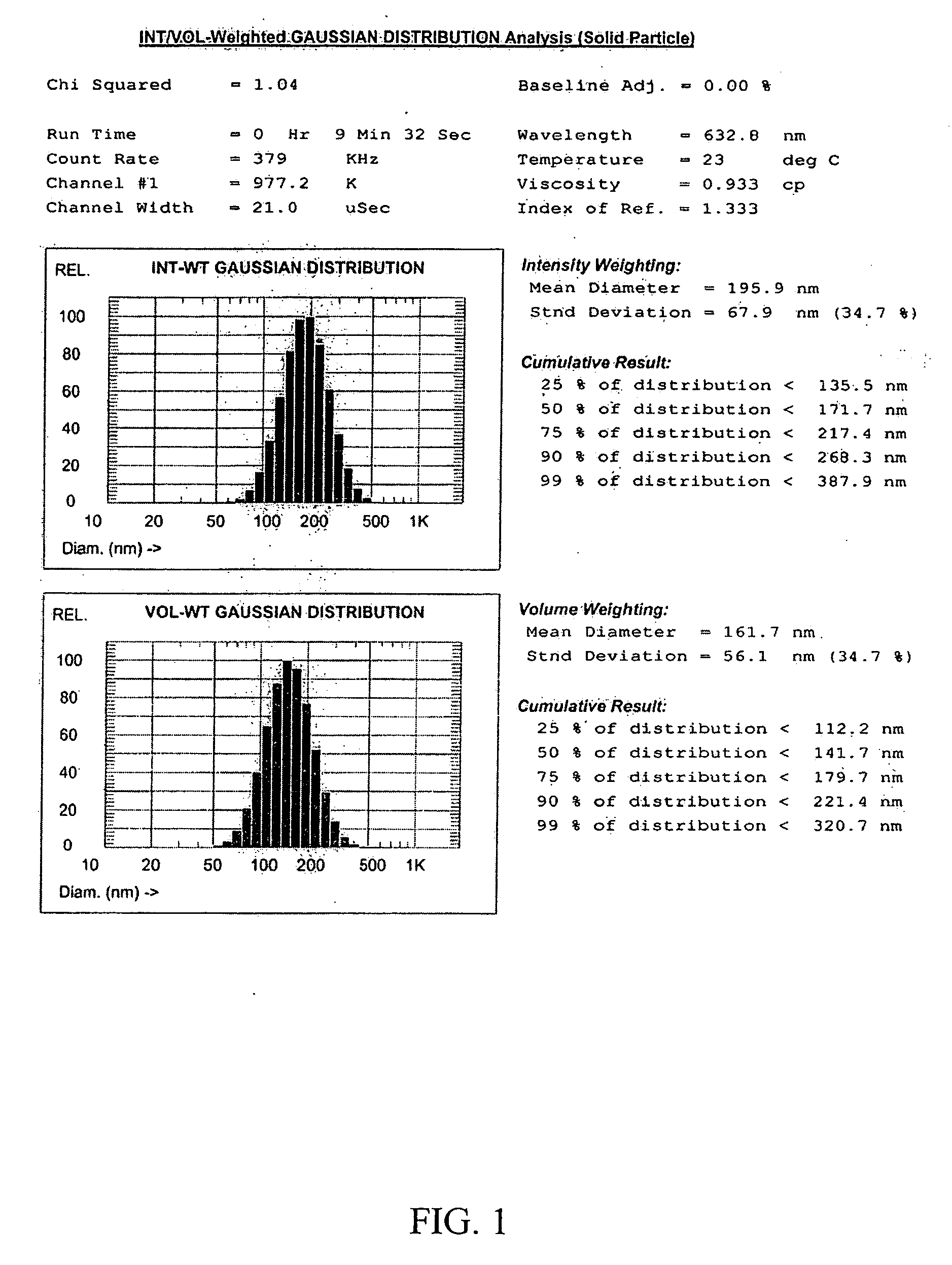Biodegradable nanoparticles
a nanoparticle, biodegradable technology, applied in the field of polymer nanoparticles, can solve the problems of not biodegradable cross-linking agents, few degradable nanoparticles composed of well-tolerated polymers, and the disclosure of cross-linking agents
- Summary
- Abstract
- Description
- Claims
- Application Information
AI Technical Summary
Benefits of technology
Problems solved by technology
Method used
Image
Examples
example 1
Synthesis of Sorbitol-Itaconic Acid Polyester
[0072] Sorbitol (1.82 g, 10 mmol) and itaconic acid (1.3 g, 10 mmol) were transferred into a 100 mL round bottom flask. The reactants were heated with stirring to 140° C. and the mixture melted. The temperature of the reaction mixture was then lowered to 90-95° C. and the reaction components remained as a viscous liquid. Then, NOVOZYM®-435 beads (Novozymes, Denmark) (10% wt / wt relative to monomers, 310 mg, dried at 25° C. / 10 mmHg / 24 hrs) were added. Within 2 hrs the reaction mixture appeared monophasic with suspended catalyst beads. The flask was sealed with a rubber septum and the reaction was maintained at 90° C. with mixing. After the first 6 hrs of the reaction, the contents of the reaction were maintained under reduced pressure (40 mmHg). The polymerization was terminated after 48 h by dissolving the reaction mixture in methanol, removing the enzyme by filtration, and stripping off the solvent in vacuo. The product was then dried i...
example 2
Synthesis of Gluconic-Acrylamidoglycolate (Gluconic-AGA) Polyester
[0073] A mixture of D-gluconic acid (11.7 g, 0.06 mol) and acrylamidoglycolic acid (3.26 g, 0.02 mol) in a 100 mL round bottom flask was heated to 160° C. to obtain a melt. The temperature of the reaction mixture was lowered to 90-95° C. and then NOVOZYM®-435 beads (Novozymes, Denmark) (10% wt / wt relative to monomers, (1.5 g), dried at 25° C. / 10 mmHg / 24 hrs) were added. The temperature of the reaction mixture was maintained at 90° C. with occasional mixing. After 6 hrs the reaction mixture was subjected to vacuum (40 mmHg) while maintaining the temperature at 90° C. for 48 h. The reaction mixture was cooled to room temperature, the polymer was extracted into methanol, and the beads were removed by filtration. The filtrate was concentrated under reduced pressure and the product (thick liquid) was further subjected to a high vacuum (24 h) to give 9.9 g of pale yellow liquid.
example 3
Synthesis of Poly Sorbitol-Itaconic Acid Nanoparticles
[0074] A clean 20 ml glass vial was charged with sorbitol itaconate polymer (1.5 g) and 4 ml of sodium phosphate buffer (10 mM, pH 7.3). The suspension was sonicated for 2 min to obtain a clear solution. Ethylene glycol diitaconate (0.5 g, 25 wt % of the polymeric monomer) was added to the reaction mixture and sonicated for an additional 5 min. The resulting slightly turbid monomer solution was added to a 250 ml round bottom flask containing an argon-purged, well stirred solution of dioctyl sulfosuccinate (AOT or Aerosol AT) (3.2 g) and Brij 30 (6.4 ml) in hexanes (100 ml). After a 10 min stirring under an argon blanket at room temperature, the reaction mixture was treated with freshly prepared aqueous ammonium persulfate (65 μl, 10%) and N,N,N′,N′-tetramethylethylenediamine (TEMED) (85 μl) to initiate polymerization. The reaction mixture was gently stirred at room temperature overnight to ensure complete polymerization.
[0075]...
PUM
| Property | Measurement | Unit |
|---|---|---|
| Diameter | aaaaa | aaaaa |
| Fraction | aaaaa | aaaaa |
| Fraction | aaaaa | aaaaa |
Abstract
Description
Claims
Application Information
 Login to View More
Login to View More - R&D
- Intellectual Property
- Life Sciences
- Materials
- Tech Scout
- Unparalleled Data Quality
- Higher Quality Content
- 60% Fewer Hallucinations
Browse by: Latest US Patents, China's latest patents, Technical Efficacy Thesaurus, Application Domain, Technology Topic, Popular Technical Reports.
© 2025 PatSnap. All rights reserved.Legal|Privacy policy|Modern Slavery Act Transparency Statement|Sitemap|About US| Contact US: help@patsnap.com



